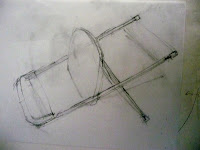The task for the day was to draw chairs, in all sorts of shapes, sizes. etc., on tracing paper, then to move the images around until a satisfactory composition happens. Draw the image on A2 paper, using charcoal and rubber, and then start to abstract it.

I found this extremely difficult as I was not sure what I was doing or why.
Moving the images around over white paper seemed great fun but when it came down to it, I could not get a satisfactory composition. Echoing shapes, finding structure, all seemed impossible. I started to wish that I had different drawings.
I tried a simple sketch to get the idea but it still seemed very contrived.
FINAL DRAWING
This is my final drawing. Charcoal on A2. I am not happy with it as the composition is not good. The page is just split diagonally and the drawing is not abstract at all.
I seemed to resort to looking at the lines and negative space in the same way as drawing the chairs in the first place. on the whole, a failure to abstract.
SECOND DAY OF ABSTRACTION
The following Friday was to introduce colour.
We started the day with a talk by Jane on the basic principles. (see below)
I also did a few tests of colour to see what combinations worked well.
I retrieved my sketches on tracing paper, tried moving them around, doing sketches of possible compositions.
I felt very unhappy with the whole process.
After a strong coffee and lots of thinking, I came to the conclusion that what I was trying to do from these individual drawings of chairs did not make sense to me.
If I was to make something out of a drawing it seemed more sensible to stick to my original vision and go from that rather than from something that felt more detached.
I went back to my earlier drawing of the chairs. (see below)
 This was my attempt at focusing into the stack of chairs and looking at the negative space, shapes and textures.
This was my attempt at focusing into the stack of chairs and looking at the negative space, shapes and textures.The second painting was experimenting with different colours and getting in closer with the shapes.
Not quite successful but better that last week's drawing.
The third painting ( right) was to use mainly blues and more tone and try to think more of the composition. The yellow was added to bring more sparkle. ( complimentary colour)
On the whole I felt happier with the day painting from from my original drawing rather than trying to created something from bits of drawings.
Perhaps the whole point of abstraction for me is to go slowly and let it evolve in time rather than make a huge leap not quite knowing what I am doing.










I sympathise. I had the same struggles with abstraction in the watercolour course and still am lost as to what makes a "good" abstract or what makes an abstract "good"- let me know if you have a lightbulb moment!
ReplyDelete